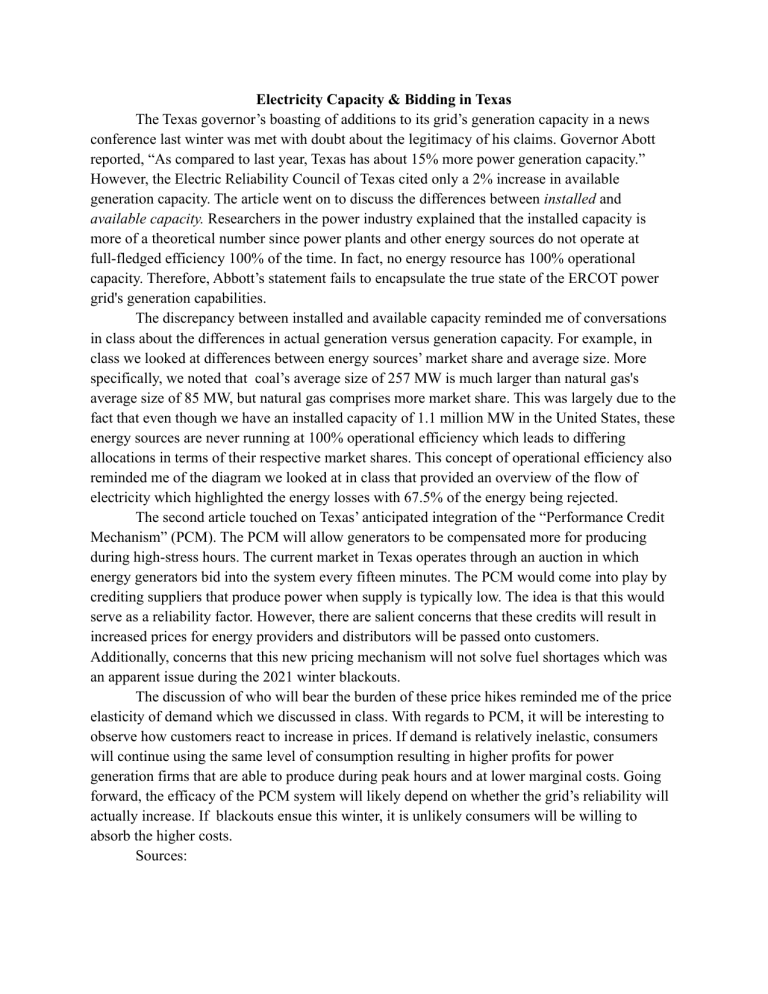
Electricity Capacity & Bidding in Texas The Texas governor’s boasting of additions to its grid’s generation capacity in a news conference last winter was met with doubt about the legitimacy of his claims. Governor Abott reported, “As compared to last year, Texas has about 15% more power generation capacity.” However, the Electric Reliability Council of Texas cited only a 2% increase in available generation capacity. The article went on to discuss the differences between installed and available capacity. Researchers in the power industry explained that the installed capacity is more of a theoretical number since power plants and other energy sources do not operate at full-fledged efficiency 100% of the time. In fact, no energy resource has 100% operational capacity. Therefore, Abbott’s statement fails to encapsulate the true state of the ERCOT power grid's generation capabilities. The discrepancy between installed and available capacity reminded me of conversations in class about the differences in actual generation versus generation capacity. For example, in class we looked at differences between energy sources’ market share and average size. More specifically, we noted that coal’s average size of 257 MW is much larger than natural gas's average size of 85 MW, but natural gas comprises more market share. This was largely due to the fact that even though we have an installed capacity of 1.1 million MW in the United States, these energy sources are never running at 100% operational efficiency which leads to differing allocations in terms of their respective market shares. This concept of operational efficiency also reminded me of the diagram we looked at in class that provided an overview of the flow of electricity which highlighted the energy losses with 67.5% of the energy being rejected. The second article touched on Texas’ anticipated integration of the “Performance Credit Mechanism” (PCM). The PCM will allow generators to be compensated more for producing during high-stress hours. The current market in Texas operates through an auction in which energy generators bid into the system every fifteen minutes. The PCM would come into play by crediting suppliers that produce power when supply is typically low. The idea is that this would serve as a reliability factor. However, there are salient concerns that these credits will result in increased prices for energy providers and distributors will be passed onto customers. Additionally, concerns that this new pricing mechanism will not solve fuel shortages which was an apparent issue during the 2021 winter blackouts. The discussion of who will bear the burden of these price hikes reminded me of the price elasticity of demand which we discussed in class. With regards to PCM, it will be interesting to observe how customers react to increase in prices. If demand is relatively inelastic, consumers will continue using the same level of consumption resulting in higher profits for power generation firms that are able to produce during peak hours and at lower marginal costs. Going forward, the efficacy of the PCM system will likely depend on whether the grid’s reliability will actually increase. If blackouts ensue this winter, it is unlikely consumers will be willing to absorb the higher costs. Sources: 1.) https://www.statesman.com/story/news/politics/politifact/2022/04/03/politifact-te xas-grids-power-generation-capacity-compared-2021/6698872001/ 2.) https://www.kxan.com/news/texas-politics/puc-approves-electric-market-redesign -in-big-step-for-ercot/